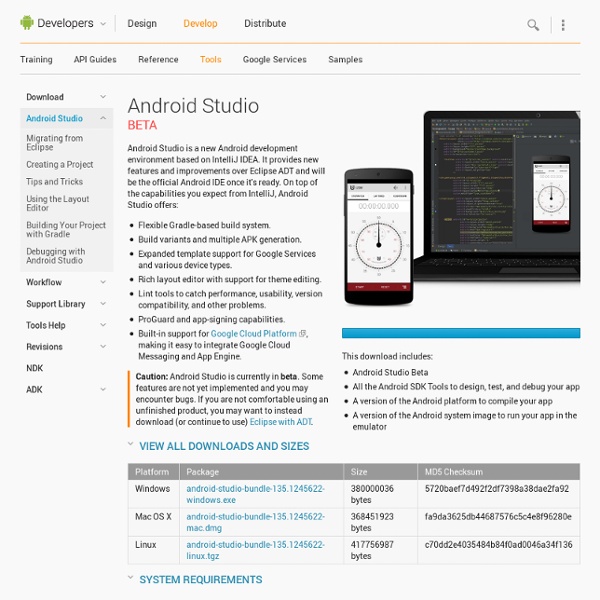



Videotutorial Instalar Android 4 en Eclipse Eclipse es la herramienta por excelencia para desarrollar aplicaciones Android, el problema es que la instalación de Android es lenta y complicada. Pero eso era antes de que Google lanzara su propia version de Eclipse que ya viene con el SDK y todas las herramientas de desarrollo instaladas. Puedes descargalo en esta dirección: Aprende a instalar y utilizar la nueva versión de Eclipse para Android en este video tutorial El paquete de desarrollo incluye: Eclipse Juno, la mas reciente version de este IDE.El SDK de Android todas las herramientas de desarrollo y emuladores.La version de ADT (Android Developer tools) preinstalada en EclipseLos paquetes y la maquina virtual de Android 4.2 (Jelly Bean). Solo tienes que instalar el paquete y en un solo paso podrás comenzar a trabajar en tus aplicaciones! No olvides suscribirte a nuestro canal de youtube! Acerca de Carlos Solis
Android Studio face à Eclipse : le comparatif Google nous a annoncé, lors du Google IO 2013, le premier IDE (Integrated Developement Environment – Environnement de développement intégré) dédié au développement Android nommé, sans rappeler d’autres suites de développement, Android Studio. J’ai donc décidé de faire un article de prise en main de cet outil, après 6 ans de développement Android sous Eclipse et avoir donné nombre de formation sur cet environnement. Petit comparatif et prise en main pas à pas ! Jusqu’à maintenant l’outil officiel était “Eclipse pour développeur Java”, couplé à un plugin dénommé Android Developer Tool (ADT). C’est dans l’ombre que les équipes de Google travaillaient sur le produit IntelliJ pour le faire évoluer et en sortir leur Android Studio. Dans un premier temps j’ai été surpris de voir que Google se basait sur IntelliJ pour créer son propre outil de développement tout simplement car Eclipse a toujours été le produit phare du développement Android – bien qu’IntelliJ ait pu depuis trouver sa place.
Android Design Patterns Eclipse Before installing Android Studio or the standalone SDK tools, you must agree to the following terms and conditions. This is the Android Software Development Kit License Agreement 1. Introduction 1.1 The Android Software Development Kit (referred to in this License Agreement as the "SDK" and specifically including the Android system files, packaged APIs, and Google APIs add-ons) is licensed to you subject to the terms of this License Agreement. 2. 2.1 In order to use the SDK, you must first agree to this License Agreement. 3. 3.1 Subject to the terms of this License Agreement, Google grants you a limited, worldwide, royalty-free, non-assignable, non-exclusive, and non-sublicensable license to use the SDK solely to develop applications for compatible implementations of Android. 3.2 You may not use this SDK to develop applications for other platforms (including non-compatible implementations of Android) or to develop another SDK. 4. 5. 6. 7. 8. 9. 12. 13. 14.
Android Developers Blog Développer dirrectement sur son smartphone c'est DataManagement Library for Easy Android Database Storage DataManagement Library for Easy Android Database Storage Storing objects to a Database for an Android application should be fast and easy as: Code: dm.add(new StorableClass()); DataManagement is a new open source library that allows you to do just that. DataManagement is a Java Android library designed to help easily and efficiently store aggregate classes to an SQLite database. Examples:Creating a Storable Class: public class StorableClass{ @Id private int ident; private int num1; private double num2; private String num3; private boolean num4; public static final int num5 = 3; private OtherStorableClass[] ds2; } A storable class must meet two requirements. Instantiating a DataManager Object: DataManager dm = new DataManager(context); The open method accepts the calling Context that is going to use the database. Opening a Database for Use: This method must be called before the database is used in any way. Closing a Database After Use: Adding an Object to the Database: dm.update(id, updatedObject);
AIDE - Android IDE - Java, C++ AIDE is an integrated development environment (IDE) for developing real Android apps directly on your Android device. Follow interactive coding lessons and step-by-step become an expert app developer. Visually design apps, write code with the feature rich editor with code completion, real-time error checking, refactoring and smart code navigation, and run your app with a single click. AIDE features interactive lessons with step-by-step instructions to learn Android app development and Java programming skills. AIDE will turn your Android tablet with keyboard into a real development box. AIDE supports building apps with Java/Xml and the Android SDK, apps with C/C++ and the Android NDK as well as pure Java console applications. A brief summary of features... Learn-to-code (in-app purchase):- Interactive lessons with step-by-step instructions- Java programming course- Android development course UI design:- Preview XML layouts- Jump from view in the designer to the XML element